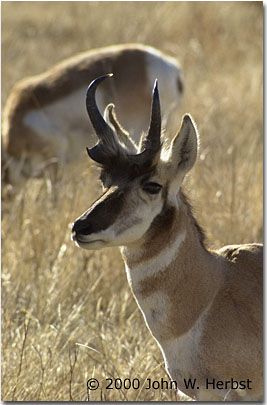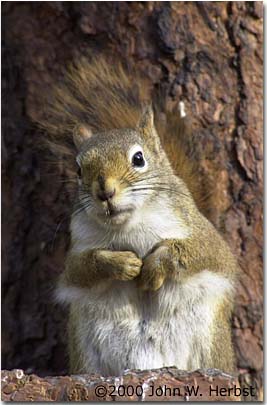
Camera Equipment Review...
Tokina 100-300/4 AT-X (340 AFll)
Text and Photography Copyright John Herbst
All rights reserved.
 For those of you who are not aware of several issues, let me lay some foundation. First, if you have followed my writing over the years, I am a great fan of Tokina products. I firmly believe that the line of Tokina lenses -especially their “Pro” series - is one of the great quality values on the photography market today. And, before someone asks, I was using Tokina products long before they began using my images in their product advertisements. I have used Tokina products for years because as a professional wildlife and nature photographer, I demand a lot from my equipment. I demand razor sharp optics, quality for my money and durability - nature photography by its nature is hard on equipment and for me, equipment breakdown translates into lost photographic opportunities that, in turn, mean lost sales.
For those of you who are not aware of several issues, let me lay some foundation. First, if you have followed my writing over the years, I am a great fan of Tokina products. I firmly believe that the line of Tokina lenses -especially their “Pro” series - is one of the great quality values on the photography market today. And, before someone asks, I was using Tokina products long before they began using my images in their product advertisements. I have used Tokina products for years because as a professional wildlife and nature photographer, I demand a lot from my equipment. I demand razor sharp optics, quality for my money and durability - nature photography by its nature is hard on equipment and for me, equipment breakdown translates into lost photographic opportunities that, in turn, mean lost sales.
Second issue - The Digital age has arrived and it has arrived in the form and features of the Nikon D1. I strongly urge everyone visiting “Nature Photographers” to take the time to read, reread and study Moose Peterson’s outstanding article concerning the Nikon D1. Having used the D1 extensively for the past few weeks, I will tell you flat out that everything that Moose says about this amazing new piece of technology is 100% true. An amazing “image machine” it truly is!
So, how does my respect for Tokina products and my love for the D1 tie together? Very well, thank you very much! For quite a while now, I have had a Tokina 100-300 f/4 in my camera bag, but to be very honest with you, I did not use it all that much. That was until now. As Moose very adeptly explains in his D1 article on this on-line magazine, the CCD (“Charge-Coupled Device” - the “film plane” device that “captures” the image at time of shutter release) is 50% smaller than the standard 35mm transparency. This has the effect of increasing the effective focal length of any given lens by 50% while maintaining the same baseline aperture!
For many years, few lenses were more coveted by wildlife and nature photographers than the Nikon 200 - 400 f/4. This amazing manual focus lens was - in the not too distant past - selling for $8000 - $10,000 and was in very scarce supply. The reasons for the popularity of this lens were several - high quality optics, a “fast” f/4 speed and versatility, versatility and, lastly, versatility.
Which brings me back to the Tokina 100-300 f/4. As I just stated above, I owned this lens, but did not utilize it all that much and, to be honest, I don’t know why. For years, the 80-200 f/2.8, the Tokina 400 f/5.6 and my Nikon 600 f/4 AF-I have been my day-to-day wildlife and nature lenses. They have served me well and will continue to do so. However, remember that word “versatility”?
Several weeks ago, I began shooting my new Nikon D1. Suddenly my Tokina 100 - 300 f/4 has become a lens with a 150 - 450 mm focal length at a constant aperture of f/4. (Does that word “versatility” sound familiar by now?) In addition, this lens has a minimum focusing distance of a mere 6 feet, is tack sharp throughout its focal length range and has a solid tripod collar. Like all of the other Tokina lenses I own, it just feels solid and the minute you pick it up you just simply can feel the quality in its workmanship. I told you I love Tokina lenses - and this is just one more reason that confirms my long-standing trust in these lenses.
 Over the past few weeks I have put this lens to the ultimate test - that of shooting wildlife. And it has performed magnificently. On my deck I have an array of over fifteen bird feeders and several red squirrel feeding stations. Every morning and evening we currently have a herd of fourteen mule deer and a flock of fifty Merriam’s Turkeys that visit. I have had a blast photographing all of these members of our “Herbst’s Wildlife Sanctuary - as our son, Caleb, refers to our yard - with this lens. As much as I still love my Tokina 400 f/5.6, this lens is more versatile for this type of shooting and its closer “minimum focusing distance” is allowing me to photograph birds that have in the past been too close for the 400 f5.6.
Over the past few weeks I have put this lens to the ultimate test - that of shooting wildlife. And it has performed magnificently. On my deck I have an array of over fifteen bird feeders and several red squirrel feeding stations. Every morning and evening we currently have a herd of fourteen mule deer and a flock of fifty Merriam’s Turkeys that visit. I have had a blast photographing all of these members of our “Herbst’s Wildlife Sanctuary - as our son, Caleb, refers to our yard - with this lens. As much as I still love my Tokina 400 f/5.6, this lens is more versatile for this type of shooting and its closer “minimum focusing distance” is allowing me to photograph birds that have in the past been too close for the 400 f5.6.
Recently, Cheryl and I spent a wonderful day in Custer and Wind Cave Parks. We saw huge numbers of wildlife including pronghorn, bison, mule and whitetail deer, and prairie dogs. I have been actively photographing Custer Park for ten years now and yesterday we were treated to the sight of the largest herd of elk that I have ever seen with over 150 animals present at dawn.
Pronghorn antelope are one of my all time favorite animals to photograph and observe. I have literally thousands of images of these speed demons of the prairie and I still want more! Pronghorn tend to be very skittish when approached, but very calm if you can utilize your vehicle as a “blind” and shoot from within. The drawback to the “vehicle blind” approach is that you are relatively stationary while pronghorn tend to be in almost constant motion. It was while photographing pronghorn yesterday that the Tokina 100-300 f/4 really performed. While shooting from a Kirk Window mount on my driver’s side window, I was able to follow and photograph the pronghorn with ease as they moved around my vehicle. The amazing zoom range of 150 - 450 mm was ideal! I was in pronghorn photographer’s heaven!
Kenko has a new pair of “Pro” series teleconverters - a 1.4X and 2.0X. To make full use of teleconverters without disappointing results you need to know and understand some simple facts. First, teleconverters must be “matched” to the lens you are using. You cannot use Brand X converter on Brand Y lens - they may not even couple together and generally there is a drastic loss of sharpness when this mistake is made. Secondly, modern autofocus cameras need a certain amount of light for them to function properly and converters cause a one-stop light loss with a 1.4x converter and a two-stop loss with a 2.0X. As a general rule, autofocus cameras need a functional f/stop of f/8 or faster in order to focus normally. I try not to go below a functional f/stop of 5.6.
Kenko converters are “matched” to Tokina lenses and I have used the Kenko Pro 1.4X converter in conjunction with the Tokina 100-300 f/4 lens. The result is an amazingly sharp 210 - 630 f/5.6 lens. Yes, the autofocus is slowed down but it is still functional for wildlife that is not running. Hmmmm - what is that word? - “Versatility”?
So, am I excited? - you bet I am! I am excited about the arrival of the truly functional
“Digital age” for the wildlife and nature photographer with the advent of the Nikon D1. I am also excited about my newly discovered wildlife and nature photography “versatility lens”, the Tokina 100-300 f/4. For those of you out there who are still fearful and distrustful of the “Digital age” I urge you to read again Moose Peterson’s article on the Nikon D1 and just allow your mind to open up to the possibilities. Then consider what a quality, affordable lens in the focal range of 150 - 450 mm with an aperture of f/4 could do for you.
I have been shooting this combination now for several weeks and when I see those images come screaming off of my computer screen, it still boggles my mind. Do yourself a favor and get your mind (and photographic world) “boggled” a little bit too. Your photographic universe will never be the same - guaranteed!
JH-NPN


|